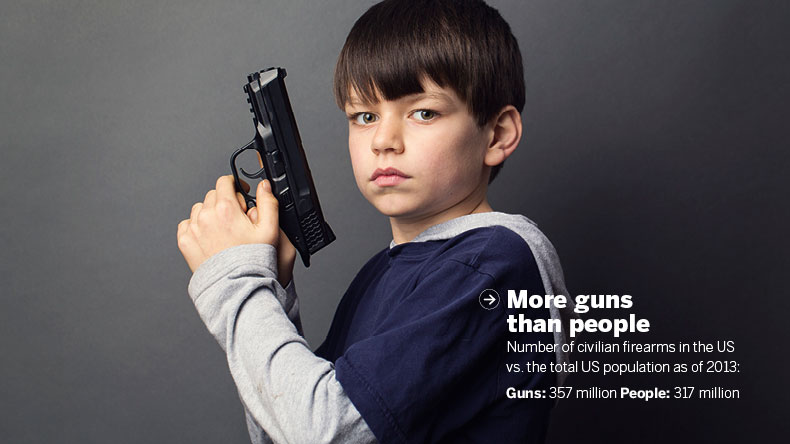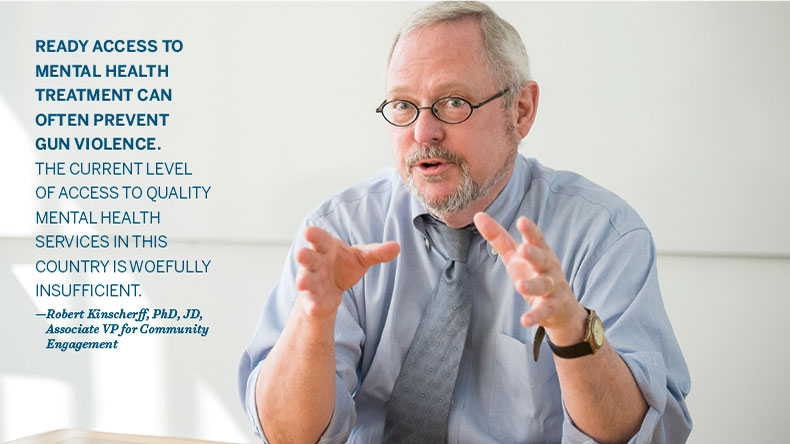A Conversation with Robert Kinscherff about Youthful Gun Violence

A Conversation with Robert Kinscherff about Youthful Gun Violence
Faculty Viewpoint
Robert Kinscherff, PhD, JD, is Associate Vice President for Community Engagement at William James College, Senior Fellow in Law and Applied Neuroscience for Massachusetts General Hospital and Harvard Law School, and Senior Associate of the National Center for Mental Health and Juvenile Justice. He recently was an invited participant at a summit on community violence at the Obama White House.
Rapport asked Dr. Kinscherff to respond to a series of questions we think our readers would find both professionally and personally relevant.
Q: Looking at age, gender, ethnicity, religion or country of birth, can we predict which young people will commit acts of gun violence?
A: No, we can’t reliably predict which individuals will commit acts of gun violence, although at times we can identify specific individuals who may be at higher risk for immediate violence. We can, however, reliably identify groups with higher or lower risks of engaging particular types of gun violence. For example, suicide by gun is most common among white mid-adolescent males who are also depressed, substance-abusing and stressed. Risks of both homicide perpetration and victimization are elevated among disenfranchised urban young adult males of color who live in poverty. But, it is important to recognize that the vast majority of younger males of all ethnicities and social backgrounds are not involved in significant violence towards themselves or others. This makes it impossible to create a “profile” that can reliably identify specific individuals who will engage in serious violence at all—much less those who will specifically engage in gun violence.

Q: What about the highly publicized mass shootings we have seen in recent years?
A: The majority of highly publicized shootings with multiple casualties such as the tragedies at Sandy Hook Elementary School, the Aurora, CO movie theater, the attempted assassination of Representative Gabrielle (Gabby) Giffords, and the church shootings in Charleston, SC were committed by young white males. And, even if all of these mass shootings could be eliminated, this would reduce total casualties from gun violence by only approximately one-half of one percent. Bottom line: there is no single biological predisposition, individual trait, life experience, social dynamic, or diagnosis of mental disorder that can satisfactorily account for the emergence of gun violence.
Q: Does the research suggest it’s all random? Are we left with nothing that could help us understand and prevent gun violence among our nation’s youth?
A: No, the research does not suggest it’s all random. In fact, while it is difficult to impossible to confidently predict in advance that a specific individual will commit an act of gun violence, research does help us identify which groups of young persons and others are at higher risks of suicide (the most common form of gun violence), homicide, and accidental injury or death. Risk for gun violence is associated with a complex confluence of individual, family, school, peer, community, sociocultural, and situational factors.
Q: If a person is suffering from mental illness, is there any community-based prediction or prevention approach that might help avoid gun violence?
A: It’s important to understand that most people suffering from a mental illness are not dangerous. But for those whose risk of violence is compounded by a serious mental illness contributing to suicidal thoughts or undue perceptions of threat or persecution, or for any person experiencing acute psychological distress and/or an overwhelming sense of desperation, ready access to quality mental health treatment can often prevent gun violence. Policies and programs that identify and provide treatment for all persons suffering from a diagnosable mental illness or even a sense of acute distress and desperation that is not a mental disorder should be a national priority. Unfortunately, the current level of access to quality mental health services in this country— including clinicians who are adequately trained in effective violence risk assessment and management—is woefully insufficient.
Q: Can you talk a bit more about prevention measures? What are they?
A: Yes. Prevention must begin long before a person with a gun walks into a school or shopping center, fires during a street encounter, or pulls the trigger during a suicide. Prevention takes place at three levels. Primary prevention measures broadly seek to promote healthy development for all children, such as curricula to teach children social skills and resolve conflicts without violence. It would also include promotion of legal, safe and responsible gun ownership. Secondary prevention targets members of groups who are at elevated risk of violence, including gun violence. This would include community-based interventions such as Cure Violence and other programs that work with higher risk individuals in communities with high rates of violence to diminish those rates. Tertiary prevention measures are for persons who have already behaved violently to reduce the likelihood that they will do so again. These would include research-based responses to juvenile and young adult violent offenders.
- Tags:
- Research & Advocacy
Topics/Tags
Follow William James College
Media Contact
- Katie O'Hare
- Senior Director of Marketing
- katie_ohare@williamjames.edu
- 617-564-9389
